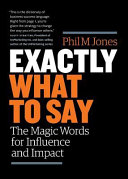

Language plays a critical role in influencing people's decisions and actions. The book emphasizes that the words we choose can significantly impact the outcomes of our conversations. By understanding the psychology behind language, we can craft our messages to resonate more with our audience. This involves using specific phrases that trigger certain responses and emotions, making our communication more effective. The author provides practical examples of how subtle changes in wording can lead to different reactions. For instance, replacing 'I want you to' with 'What would you like to...' can create a more collaborative atmosphere, encouraging the other person to engage positively. The book underlines that mastering the art of language can lead to better relationships, negotiations, and overall success in various aspects of life.
Continue readingTiming is crucial in communication, and the book highlights how delivering the right message at the right moment can enhance its effectiveness. The author discusses the concept of 'timing' in conversations, suggesting that there are optimal moments to introduce certain ideas or proposals. For example, presenting a solution to a problem when the other party is feeling frustrated can lead to a more receptive response. The book also emphasizes the need to be aware of the emotional state of the person you are communicating with, as this can greatly influence their receptiveness. By being attuned to these dynamics, one can maximize the impact of their words and foster more productive dialogues.
Continue readingThe book advocates for fostering a collaborative environment in conversations. This involves using language that promotes teamwork and shared goals. The author suggests that phrases like 'Let’s work together on this' or 'How can we solve this together?' can shift the focus from individual agendas to collective problem-solving. By framing discussions in a way that emphasizes collaboration, individuals can build trust and rapport, making it easier to navigate challenges and achieve mutual objectives. The book provides strategies for cultivating a collaborative mindset, which is essential for effective leadership and teamwork in any setting.
Continue readingQuestions are powerful tools in communication, and the book outlines how to use them strategically to guide conversations. The author emphasizes the importance of open-ended questions that encourage exploration and dialogue. For instance, asking 'What do you think about this approach?' invites the other person to share their thoughts and engage more deeply in the conversation. The book also discusses the role of leading questions, which can subtly steer discussions in a desired direction without imposing one's views. By mastering the art of questioning, individuals can foster more meaningful interactions and uncover valuable insights.
Continue readingTrust is a foundational element in any relationship, and the book stresses the importance of transparency in building that trust. The author argues that being open about intentions and motivations can help dispel doubts and foster a sense of security in conversations. Phrases like 'I want to be honest with you' or 'Let me explain my reasoning' can create an atmosphere of openness that encourages others to reciprocate. The book provides examples of how transparency can lead to more honest and productive discussions, ultimately strengthening relationships and enhancing collaboration.
Continue readingEmpathy is a crucial component of effective communication, and the book highlights how understanding the feelings and perspectives of others can enhance interactions. The author encourages readers to practice active listening and to validate the emotions of others in conversations. Phrases like 'I can see how you feel' or 'That sounds really challenging' can demonstrate empathy and create a connection with the other person. By incorporating empathy into communication, individuals can build stronger relationships, resolve conflicts more effectively, and create a more supportive environment.
Continue readingPersuasion is a key theme in the book, and the author outlines techniques for influencing others positively. This involves not only the choice of words but also the delivery and context of the message. The book discusses the importance of establishing credibility and rapport before attempting to persuade someone. Techniques such as storytelling, appealing to emotions, and presenting logical arguments are explored as ways to enhance persuasive communication. By understanding the principles of persuasion, individuals can effectively convey their ideas and inspire action in others.
Continue reading